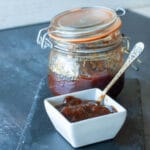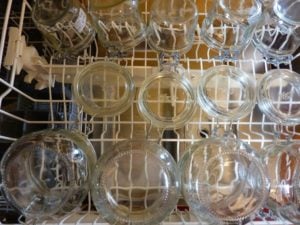
📋 Fig Balsamic Glaze Recipe
This balsamic fig glaze recipe is a savory fig preserve made with fresh figs. It keeps for the winter and it is a unique delicacy to serve at Christmas. In France, it is served with foie gras as the sweet fruity flavor breaks and balances the intense richness of the duck liver. This balsamic fig sauce can also be served with pork, wild boar, venison, or any other wild meat whose strong flavor combines well with a sweet fruity sauce.
Servings 2 jars
Calories 871kcal
Equipment
- Copper Sauce Pan 3 Qt optional
Ingredients
For the fig relish
- 25 oz figs
- 1 ½ cup caster sugar
- ½ cup water
- 4 tablespoon balsamic vinegar
- 1 pinch freshly grated nutmeg
- 1 pinch salt
Instructions
- Peel the figs25 oz figs
- Bring to boil water and sugar in a stainless steel pot1 ½ cup caster sugar, ½ cup water
- Once the sugar is dissolved, add the figs
- Combine the nutmeg, the balsamic vinegar and a pinch of salt4 tablespoon balsamic vinegar, 1 pinch freshly grated nutmeg, 1 pinch salt
Cooking the fig glaze
- Let the jam simmer stirring regularly
- Remove with a skimmer the foam rising on the surface
- Boil until the figs are melted into a jam
- To know when the glaze is ready, place a teaspoon of fig glaze on a small plate and tilt it
- The jam is ready when it doesn't slide down the plate
Canning the fig sauce
- Sterilize the jars in the dishwasher or boil them

- Fill them with the fig glaze
- Cover the top with cellophane if you want to make sure no metal is touching the jam
- Seal while still hot and let them cool down in a dry place cover with a cloth
How to serve it
- Fill a small serving bowl with some fig jam and bring it to the table.
- Place a slice of the foie gras on a slice of savory brioche and a small teaspoon of fig jam on top
Video
Notes
- Use matured figs and a good quality Balsamic vinegar
- Never use aluminum pots for cooking fruits and vegetables. Best to use stainless steel or copper
- Sterilize your jars in the dishwasher
- You can re-utilize the glass jars, but you need to buy new lids
- When you open the can, ensure that there is a vacuum. If not, the jar was not properly pasteurized and should not be consumed.
Nutrition
Calories: 871kcal | Carbohydrates: 223g | Protein: 3g | Fat: 2g | Saturated Fat: 0.3g | Polyunsaturated Fat: 1g | Monounsaturated Fat: 0.3g | Sodium: 35mg | Potassium: 863mg | Fiber: 10g | Sugar: 212g | Vitamin A: 504IU | Vitamin C: 7mg | Calcium: 137mg | Iron: 2mg